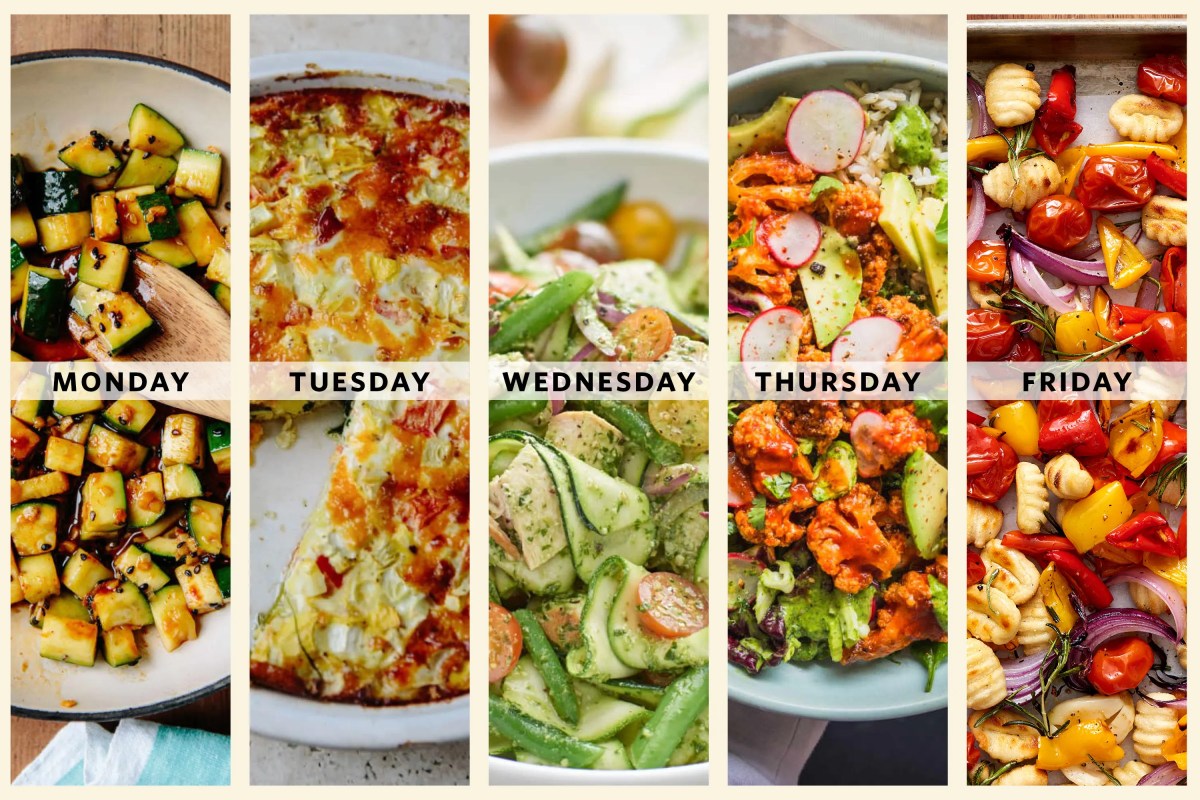Embark on a culinary journey to create the ultimate flexitarian meal prep plan! This comprehensive guide will transform your approach to healthy eating, seamlessly blending the flexibility of a flexitarian diet with the efficiency of meal prepping. We’ll delve into the principles of flexitarian eating, crafting a personalized weekly menu, developing delicious and diverse recipes, mastering efficient meal prep techniques, and conquering the challenges of long-term commitment. Prepare to discover a balanced and sustainable approach to nutrition that fits effortlessly into your lifestyle.
From understanding the nuances of flexitarian eating – a diet that embraces plant-based meals while occasionally including meat and other animal products – to mastering the art of efficient meal preparation and storage, this guide is your roadmap to a healthier, happier you. We’ll equip you with practical strategies, delectable recipes, and actionable tips to make flexitarian meal prepping not just achievable, but genuinely enjoyable. Get ready to redefine your relationship with food and discover the vibrant possibilities of this flexible and fulfilling dietary approach.
Understanding Flexitarian Diets
The flexitarian diet, a flexible approach to vegetarianism, is gaining popularity as people seek a more sustainable and health-conscious way of eating. It emphasizes plant-based foods while allowing occasional consumption of meat, poultry, and seafood. This approach offers a balance between the benefits of vegetarianism and the flexibility of an omnivorous diet.
Flexitarian eating is characterized by a predominantly plant-based diet with occasional inclusion of animal products. Its core principles revolve around maximizing the consumption of fruits, vegetables, legumes, whole grains, and nuts while minimizing the intake of processed foods, refined sugars, and unhealthy fats. This dietary pattern promotes a gradual shift towards a more plant-centered lifestyle, making it a more approachable and sustainable option for many compared to a sudden and drastic change.
Flexitarian Diets Compared to Other Dietary Patterns
The flexitarian diet occupies a middle ground between strict vegetarianism and omnivorous eating. Unlike vegetarians, who completely abstain from meat, poultry, and seafood, flexitarians incorporate these foods sparingly. Conversely, they differ from omnivores who regularly consume animal products, as flexitarians prioritize plant-based meals and consciously limit their meat consumption. This approach allows for greater dietary flexibility and avoids the potential nutritional deficiencies associated with restrictive diets, while still reaping many of the health benefits associated with a predominantly plant-based diet. For example, a strict vegetarian may need to carefully plan their meals to ensure adequate protein and iron intake, while a flexitarian can easily supplement these nutrients with occasional meat consumption.
Nutritional Considerations for Balanced Flexitarian Meal Planning
A well-planned flexitarian diet provides a wide array of essential nutrients. However, careful consideration is crucial to ensure adequate intake of protein, iron, vitamin B12, and omega-3 fatty acids, nutrients often found in higher concentrations in animal products. To address these potential nutritional gaps, flexitarians should focus on incorporating protein-rich plant sources like legumes (beans, lentils, chickpeas), tofu, tempeh, quinoa, and nuts. Iron-rich foods such as spinach, lentils, and fortified cereals are important, along with foods that enhance iron absorption, such as vitamin C-rich fruits and vegetables. Vitamin B12 supplementation may be necessary, as it’s primarily found in animal products. Omega-3 fatty acids can be obtained through plant-based sources like flaxseeds and chia seeds, although they may not provide the same EPA and DHA profile as found in fatty fish. A balanced flexitarian meal plan should also include a wide variety of colorful fruits and vegetables to ensure a comprehensive intake of vitamins, minerals, and antioxidants. A visual representation might be a plate with half filled with vibrant vegetables and fruits, a quarter with whole grains or legumes, and a smaller quarter containing a lean protein source, perhaps fish or a small portion of chicken. This image conveys a balanced and colorful meal that reflects the principles of flexitarian eating.
Planning Your Weekly Flexitarian Menu

Crafting a successful flexitarian meal plan requires careful consideration of diverse protein sources, minimizing waste, and maximizing efficiency. A well-structured plan ensures you enjoy a variety of flavors and nutrients while reducing your environmental impact and saving time in the kitchen. This section will guide you through creating a sample weekly menu, organizing it for optimal efficiency, and generating a corresponding shopping list.
A well-planned flexitarian menu offers a vibrant palette of flavors and textures, balancing lean proteins with wholesome plant-based options. This approach promotes both health and sustainability.
Sample Weekly Flexitarian Meal Plan
This sample plan demonstrates how to incorporate diverse protein sources throughout the week, ensuring a balanced and exciting dietary experience. Each meal is designed to be relatively quick to prepare, minimizing time spent in the kitchen while maximizing nutritional value.
| Day | Meal | Protein Source | Other Ingredients (Illustrative) |
|---|---|---|---|
| Monday | Lentil Soup | Red Lentils | Carrots, celery, onion, vegetable broth, spices |
| Monday | Quinoa Salad | Quinoa | Cucumber, tomatoes, feta cheese, olives, lemon vinaigrette |
| Tuesday | Chicken Stir-fry | Chicken Breast | Broccoli, bell peppers, snow peas, soy sauce, ginger |
| Tuesday | Black Bean Burgers | Black Beans | Brown rice, corn, spices, breadcrumbs |
| Wednesday | Tofu Scramble | Tofu | Spinach, mushrooms, onions, nutritional yeast |
| Wednesday | Brown Rice with Roasted Vegetables | Brown Rice | Broccoli, Brussels sprouts, sweet potatoes, olive oil, herbs |
| Thursday | Salmon with Roasted Asparagus | Salmon | Asparagus, lemon wedges, dill |
| Thursday | Lentil Curry | Green Lentils | Coconut milk, spinach, chickpeas, spices |
| Friday | Chicken and Vegetable Skewers | Chicken Breast | Bell peppers, zucchini, onions, marinade |
| Friday | Mixed Green Salad | Mixed Greens | Various vegetables, nuts, seeds, light vinaigrette |
| Saturday | Vegetarian Chili | Kidney Beans, Black Beans | Corn, tomatoes, onions, chili powder |
| Saturday | Cornbread | Cornmeal | Eggs, milk, sugar |
| Sunday | Roast Chicken with Potatoes and Carrots | Chicken | Potatoes, carrots, rosemary, thyme |
| Sunday | Leftover Chili | Kidney Beans, Black Beans | (from Saturday) |
Minimizing Food Waste and Maximizing Efficiency
Careful planning significantly reduces food waste and kitchen time. This involves using leftovers creatively, choosing recipes that utilize similar ingredients, and buying only what you need.
Strategies include using leftover chicken from Sunday’s roast in a salad or soup during the week. Planning meals that incorporate similar vegetables reduces the chance of spoilage. For example, using leftover roasted vegetables from one meal as a side dish in another meal.
Creating a Shopping List
Organizing your shopping list by grocery store section saves time and ensures you don’t forget anything. This organized approach simplifies your shopping experience.
Categorizing items by section (produce, dairy, meat, pantry, etc.) allows for efficient navigation through the store.
| Grocery Section | Items |
|---|---|
| Produce | Carrots, celery, onion, broccoli, bell peppers, snow peas, spinach, mushrooms, asparagus, potatoes, carrots, zucchini, mixed greens, tomatoes, cucumber, sweet potatoes, Brussels sprouts, lemon, dill, rosemary, thyme, corn |
| Meat & Seafood | Chicken breast, salmon |
| Dry Goods/Pantry | Red lentils, green lentils, quinoa, black beans, kidney beans, brown rice, cornmeal, soy sauce, ginger, spices (various), coconut milk, nutritional yeast, breadcrumbs, olive oil, herbs |
| Dairy & Refrigerated | Feta cheese, eggs, milk, vegetable broth |
| Frozen | (Optional: Frozen vegetables for convenience) |
Adapting Your Plan
Creating a truly effective flexitarian meal prep plan hinges on its adaptability. A rigid plan, ignoring individual needs and preferences, is destined for failure. The key is to build a framework that’s flexible enough to accommodate your lifestyle, dietary restrictions, and evolving tastes. This section will guide you through personalizing your plan, overcoming common challenges, and staying motivated on your flexitarian journey.
A personalized flexitarian meal prep plan should be more than just a list of recipes; it’s a dynamic tool that evolves with you. Think of it as a living document, constantly refined and adjusted based on your experiences and feedback. This allows you to maintain enthusiasm and avoid the pitfalls of restrictive diets.
Personalized Flexitarian Meal Prep Plan Template
This template provides a structured approach to creating a personalized plan, allowing for easy adaptation and tracking of progress. Remember to fill this out weekly to best reflect your current needs and preferences.
| Day | Breakfast | Lunch | Dinner | Snacks | Notes (Dietary needs, substitutions, etc.) |
|---|---|---|---|---|---|
| Monday | Overnight Oats with Berries | Lentil Soup with Whole-Wheat Bread | Quinoa Salad with Roasted Vegetables and Chickpeas | Apple slices with almond butter | Substitute oats with quinoa if needed. |
| Tuesday | Scrambled eggs with spinach | Leftover Quinoa Salad | Black Bean Burgers on whole-wheat buns | Handful of almonds | Can substitute black beans with lentils. |
| Wednesday | Smoothie with fruit, spinach, and protein powder | Salad with grilled chicken or tofu | Pasta with marinara sauce and vegetables | Greek yogurt | Adjust portion sizes based on activity level. |
| Thursday | Toast with avocado | Leftover pasta | Vegetarian Chili | Carrot sticks with hummus | Consider adding beans to chili for extra protein. |
| Friday | Yogurt parfait with granola and berries | Leftover Vegetarian Chili | Pizza with whole-wheat crust and plenty of vegetables | Popcorn | Choose lean protein toppings for pizza. |
| Saturday | Pancakes (whole wheat) with fruit | Salad with grilled salmon | Stir-fry with tofu and brown rice | Fruit salad | Adjust portion sizes based on weekend activities. |
| Sunday | Breakfast burrito with eggs, beans, and vegetables | Leftover stir-fry | Roasted chicken with sweet potatoes and green beans | Trail mix | Consider using pre-cut vegetables for time saving. |
Common Challenges and Solutions
Maintaining a flexitarian diet requires awareness of potential obstacles and proactive strategies to overcome them. Understanding these challenges allows for a more sustainable and enjoyable dietary approach.
| Challenge | Solution |
|---|---|
| Finding time for meal prep | Dedicate a specific time each week for prepping ingredients and cooking larger batches of meals. Consider batch cooking on the weekend. |
| Lack of variety | Explore diverse recipes and cuisines. Utilize online resources and cookbooks for inspiration. |
| Social situations and dining out | Plan ahead and choose restaurants with vegetarian or flexitarian-friendly options. Communicate your dietary needs clearly. |
| Cost concerns | Plan your meals around seasonal produce. Utilize budget-friendly staples like beans, lentils, and rice. |
| Balancing protein intake | Incorporate plant-based protein sources like legumes, tofu, tempeh, nuts, and seeds. Consider incorporating lean meats or fish strategically. |
Maintaining Motivation and Overcoming Obstacles
Long-term success with any dietary change requires consistent effort and a proactive approach to maintaining motivation. Staying committed to a flexitarian meal plan involves addressing potential setbacks and celebrating successes along the way.
- Track your progress: Keep a food journal or use a meal-planning app to monitor your intake and identify areas for improvement.
- Set realistic goals: Start with small, achievable changes and gradually incorporate more flexitarian meals into your diet.
- Find support: Connect with friends, family, or online communities who share your dietary goals. Share recipes and experiences.
- Reward yourself: Celebrate milestones with non-food rewards, such as a new cookbook, a relaxing activity, or a new piece of workout gear.
- Don’t be afraid to adjust: Your plan should evolve with your needs and preferences. Flexibility is key to long-term success.
Mastering the art of flexitarian meal prepping unlocks a world of culinary creativity and nutritional well-being. By understanding the core principles, designing a personalized plan, and implementing efficient techniques, you’ll effortlessly navigate the path to a healthier lifestyle. Remember, consistency is key. Embrace the flexibility of this approach, celebrate your successes, and adapt your plan as needed. With dedication and a touch of culinary adventure, you’ll soon be enjoying delicious, nutritious, and perfectly prepped flexitarian meals week after week.
Top FAQs
What are some common pitfalls to avoid when starting a flexitarian meal prep plan?
Common pitfalls include inadequate planning leading to food waste, insufficient protein intake, and lacking variety in meals, leading to boredom and decreased adherence. Careful planning and diverse recipe selection are crucial.
How can I make my flexitarian meal prep plan more budget-friendly?
Prioritize seasonal produce, buy in bulk when possible (for staples like grains and beans), plan meals around sales, and utilize leftovers creatively to minimize food waste.
Can I adapt a flexitarian meal prep plan to accommodate specific allergies or intolerances?
Absolutely! Simply substitute ingredients based on your dietary needs. For example, swap dairy for plant-based alternatives, or gluten-containing grains for gluten-free options. Always carefully check ingredient labels.
How long can I store prepped flexitarian meals in the refrigerator?
Most prepped meals should be stored in airtight containers and consumed within 3-4 days for optimal freshness and safety. Always ensure proper refrigeration temperatures.


